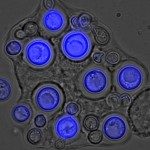Link to Pubmed [PMID] – 23152480
J. Antimicrob. Chemother. 2013 Mar;68(3):690-6
OBJECTIVES: The aims of the study were to assess in patients with advanced HIV disease receiving antiretroviral therapy (ART) intensification with enfuvirtide (i) resistance at virological failure (VF), (ii) impact of baseline tropism on immunovirological response, and (iii) HIV-1 DNA tropism evolution during ART.
METHODS: The ANRS 130 APOLLO randomized trial evaluated in naive patients the immunovirological impact of standard ART without (control arm) or with enfuvirtide. Tropism was determined on RNA and DNA by V3-loop sequencing interpreted using the Geno2Pheno algorithm.
RESULTS: At baseline the median CD4 cell count was 30 cells/mm(3). Among the 170 patients assessable in this virological substudy, HIV-1 RNA tropism was as follows: 60% of viruses were R5 and 40% were R5X4/X4. HIV-1 DNA tropism was as follows: 54% were R5 and 46% were R5X4/X4. At week 24, 39% and 49% of patients experienced VF in the enfuvirtide and control arms, respectively. In the enfuvirtide arm, only resistance-associated mutations to enfuvirtide were detected. In the control arm, two patients displayed drug-resistant viruses at the time of VF. No impact of baseline tropism was observed on immunovirological response, regardless of the study arm. Among the 25 patients experiencing DNA tropism switch between baseline and week 24, 16 (64%) switched from R5 to R5X4/X4. These latter were mostly successfully suppressed patients receiving enfuvirtide and exhibiting poorer immunological response.
CONCLUSIONS: Baseline RNA tropism had no impact on the immunovirological response. Drug resistance mutations were only detected for the fusion inhibitor. Finally, the mechanism of replenishment of the viral cellular reservoir with X4 viruses observed needs to be further analysed.

